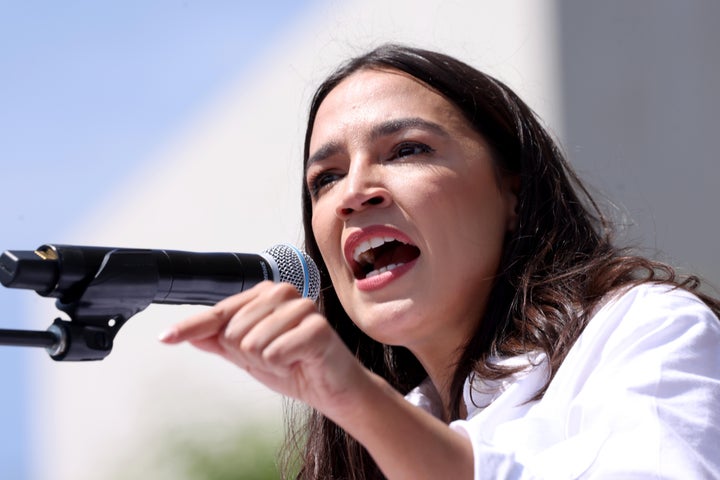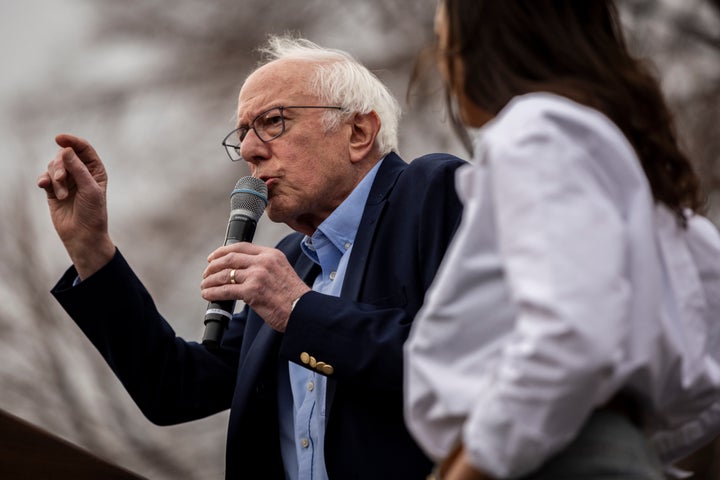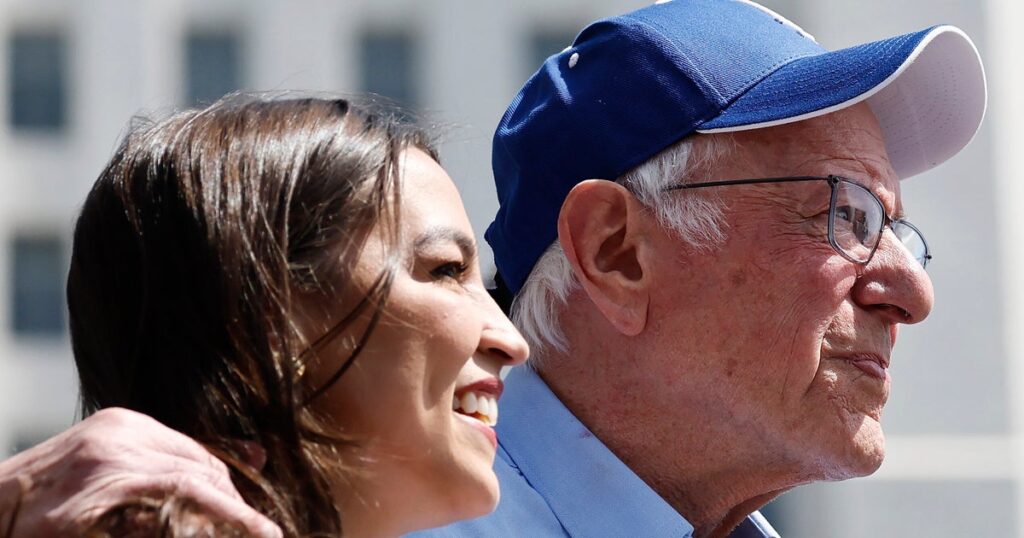On the eve of summer tour season, the hottest ticket in town isn’t Lady Gaga or Beyoncé: it’s the “Fighting Oligarchy” tour.
For the past month, Sen. Bernie Sanders (I-Vt.) and Rep. Alexandria Ocasio-Cortez (D-N.Y.) have criss-crossed across western states, making the case that the system is broken, and President Donald Trump and his allies are only involved in government to enrich themselves.
Democrats ― directionless after their general election loss and reeling from everything Trump has accomplished in his first 100 days in office ― have come out in droves to hear what the progressive pair have to say: In Los Angeles, the crowd was 36,000 strong. In Denver, 34,000.
Crowds in red states and conservative bubbles have been surprisingly receptive to their message, too: In Salt Lake City, 20,000 squeezed into the area at the University of Utah. In Idaho,12,000-plus came out. Ocasio-Cortez and Sanders drew a three-mile long line at their rally in Folsom, California ― a place where the population reliably votes red.
“I heard … that someone started flying a plane with a banner that said, ‘This is Trump country.’ It sure don’t look like it today,” Ocasio-Cortez said to the crowd of 30,000 people.
What’s hitting home for voters? Having honed their message for years, both AOC and Bernie come across as authentic ― but more than that, crowds are coming out because they’re looking for a Democrat leader who actually wants to fight, according to Ted Widmer, a speechwriter and senior adviser to President Bill Clinton.
“In a dark moment, [Sanders and Ocasio-Cortez] are standing up fearlessly, and articulating their vision for a less cruel America. People like that kind of courage,” Widmer said. “It’s the spirit of the rallies that’s creating a kind of bonfire on the prairies.”
David Litt, a former Barack Obama speech writer, sees this as a kind of passing the torch moment for Sanders, 83, and Ocasio-Cortez, 35. The former has been the standard bearer for the left wing of the party for decades. The latter is someone who many, pollster Nate Silver included, predict will be the 2028 Democratic presidential nominee.
Mario Tama via Getty Images
Not everyone is a fan, though. Ken Khachigian, a speechwriter strategist to Presidents Ronald Reagan and Richard Nixon, is not a fan of the “Fighting Oligarchy” tour, either, calling AOC and Sanders both “unserious communicators.” (More specifically, he compared Sanders to a “crazed old man shouting on the street corner.”)
“They are both the perfect demagogues for the age, feeding grievances and reading from old leftist and socialist scripts ― perfect Upton Sinclair wannabes,” he said.
Not to mention, big crowds are promising. But Litt says to consider them with some caution ― after all, former Vice President Kamala Harris drew record-size crowds before losing the election to Trump.
That said, as someone who had his entire professional life turned upside down because of Obama’s ability to inspire and activate large crowds to vote, Litt isn’t dismissing the fanfare over AOC, either.
“I think Democrats have largely discounted the ability to draw crowds, or discounted its importance,” he said. “I think it’s genuinely important, especially if you can do it in red states.”
What in particular are crowds responding to? Below, we ask speechwriters ― those who’ve written for Democrats and Republicans ― to break down just what’s so electrifying about AOC and Bernie’s “Fighting Oligarchy” tour.
AOC can say she’s one of the working class and mean it.
After his federal indictment, Trump famously told his followers, “In the end, they’re not coming after me. They’re coming after you — and I’m just standing in their way.”
In Las Vegas, the first stop of the “Fighting Oligarchy” tour, Ocasio-Cortez said something similar after Alina Habba ― Trump’s lawyer (and now U.S. attorney in New Jersey) ― had gone on Fox News and mocked AOC for once working at a bar.
“I don’t care what this woman says about me — but I want you to understand that she isn’t just talking about me, she’s talking about you. She’s talking about all of us,” Ocasio-Ortez told the crowd.
It’s an incredibly effective approach for the congresswoman, said Daron Christopher, a senior director at Bully Pulpit International, and a former speechwriter for officials at the State Department and Energy Department during the Obama years.
“In Trump’s case, there’s less reliability ― not too many Americans are in danger of being prosecuted for keeping classified documents in their bathrooms ― but Rep. Ocasio-Cortez can make a more intuitive case when Trump’s lawyer says she’s not not qualified to have a voice on topics like foreign affairs because she was a bartender,” Christopher said.
He pointed to one line he found especially effective in Ocasio-Cortez’s response to Habba: “Trump hired her to speak for him so imagine what it means for our country that the president’s own lawyer cannot even conceive of a working class person being intelligent simply because of the job that they have,” she said.

Natalie Behring via Getty Images
The ‘no red states, no blue states’ stuff is classic Obama.
One thing that sets these speeches apart is how they’re happening in parts of Red America that rarely see national Democratic figures: Utah, Idaho, Montana. This tour is an appeal to all Americans, and for voters exhausted by polarization (and maybe even Trump) that matters immensely.
“When Sen. Sanders says, ‘We don’t accept this blue state, red state nonsense,’ he’s delivering a gruffer rendition of President Obama’s 2004 ‘there are no red states or blue states’ unity message for a gruffer time,” Christopher said.
By taking this message to parts of the map that are usually considered “out of play” during presidential elections, Christopher said Sanders and Ocasio-Cortez are signaling that they’re not trying to eke out narrow victories. Instead, they’re “focused on building a broader base of support over the long term.”
AOC’s commitment to her message could be good for her 2028 chances.
Michael Ricci, the former Maryland Director of Communications and speechwriter to Speaker John Boehner and Paul Ryan, gives Ocasio-Cortez credit for really homing in on her message. The talking points she’s delivering now on this tour work because they’ve been part of her brand since she first ran for office in 2018, he told HuffPost.
“Sometimes we see politicians and you can tell they’re simply getting whatever the message testing says, and they’re trying to sort of fit it into their stump speeches,” he said.
“That led to a generation of Democrats talking about the cliches of ‘building an economy from the middle out,’ but Ocasio-Cortez doesn’t really traffic in that,” he said. “If you go back to what she was talking about when she ran her primary in 2018, it’s all very similarly aimed at ‘taking on the system.’”
She’s comfortable delivering that message, and that reads as authentic to audiences.
“She’s been honing this pitch in a way that’s very similar to Trump, actually,” Ricci said, pointing to clips of Trump talking about the need for tariffs way back in the 1980s.
“These people spend a long time building out their thoughts about things they want the public to identify them with,” he added.

Genaro Molina via Getty Images
They’re naming names.
Litt noticed that Ocasio-Cortez hasn’t shied away from calling out Marjorie Taylor Greene by name, which he thinks is a reflection of “where we are politically.”
“It’s not overly personal like Trump, but it’s not saying ‘some people’ or ‘some of our friends across the aisle,’” he said. “It’s being very direct about naming names, and that kind of directness and bluntness reads as more authentic to a lot of people who spend a lot of time on the internet these days.”
The former Obama speechwriter also thinks it demonstrates a sense of urgency that more traditional, formal speakers often struggle to convey.
“Think of the phrase ‘grave concern,’ for instance,” he said. “Given everything that’s going on in the country, when you hear leaders say they express ‘grave concern,’ it almost sounds like the opposite of what they’re saying, right? That’s not what we’re seeing here with Bernie and AOC.”

Chet Strange via Getty Images
It’s a crazy plan, but zeroing in on ‘the oligarchy’ just may work.
Christopher doubts many consultants or pollsters would greenlight the word “oligarchy” ― though the term did spike in online searches after President Joe Biden used it in his farewell speech. But somehow it works for Bernie.
“It may well resonate more effectively than Sen. Sanders’ long-time critiques of ‘millionaires and billionaires,’” he said. “I think ‘oligarchy’ suggests that the problem isn’t amassing wealth to buy a second home, but using wealth to outright buy elections.”
In framing it this way, the problem isn’t aspiring to be rich but using those riches to control the levers of power, Christopher said.
“Lots of potential Democratic voters aspire to retire early or buy a vacation house someday but are still turned off by the idea of amassing more wealth than the bottom half of American society,” he said.
At 83 years old, Sanders continues to break every rule in the modern speechwriting handbook ― and his use of “oligarchy” is proof of that.
“He doesn’t often tell personal stories. He doesn’t usually share anecdotes about people he met on the campaign trail,” Christopher said. “He goes for the head over the heart, talking about issues like inequality with a firehose of statistics, whether he’s at a town hall or opening for Clairo at Coachella.”
He also speaks for far longer than most politicians who aren’t named Trump or Castro, Christopher joked.
“Ignoring most of the common tropes of contemporary political speeches, Bernie comes across as far more authentic, and that’s really a key to his enduring political appeal.”
Read the full article here








